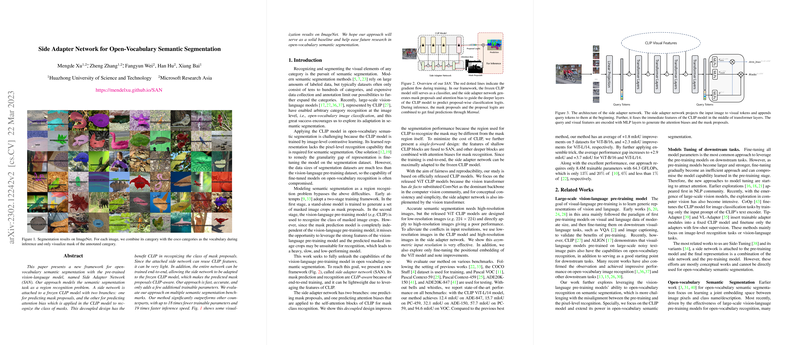Analysis of "Side Adapter Network for Open-Vocabulary Semantic Segmentation"
The paper "Side Adapter Network for Open-Vocabulary Semantic Segmentation" presents a novel framework, termed the Side Adapter Network (SAN), that leverages pre-trained vision-LLMs, specifically CLIP, to address the challenges inherent in open-vocabulary semantic segmentation. This research is innovative in modeling semantic segmentation as a region recognition task using an auxiliary side network attached to a frozen CLIP model.
Overview and Methodology
Central to the proposed approach is the modeling of semantic segmentation as a problem of region recognition, using a side network comprising two branches: one for predicting mask proposals and the other for predicting attention biases applied within the CLIP model to classify masks. This separation allows for the effective use of CLIP's feature representations, aimed at keeping the additional parameters to a minimum.
A conventional limitation when using CLIP directly for such tasks is its lack of pixel-level recognition due to its training primarily through image-level contrastive learning. The authors' solution is to design a lightweight, decoupled side network that can adapt to the frozen CLIP model through end-to-end training. This design significantly enhances both the efficiency and performance of semantic segmentation, notably with fewer trainable parameters.
Key components of SAN include:
- Feature Fusion: It efficiently merges features from the middle layers of CLIP with SAN’s processing stream, allowing SAN to utilize powerful image representation features learned by CLIP while keeping computation costs contained.
- Attention Biases: By introducing an auxiliary set of [SLS] token copies, SAN enhances the attention mechanism of CLIP, enabling it to effectively recognize masks.
Empirical Results
The paper reports substantial improvements over existing methods in terms of trainable parameters, inferences speed, and segmentation quality. SAN was tested on benchmarks like Pascal VOC, ADE20K, and COCO Stuff. Impressively, it offers an average mean Intersection over Union (mIoU) improvement of up to 2.3 points over the best baseline methods without resorting to ensemble techniques.
By leveraging the fused CLIP model features, SAN dramatically reduces the complexity typical of two-stage approaches, providing a lean and effective alternative. The single-forward computation design reduces costs considerably compared to two-pass processing, where predictions and classifications occur in separate phases.
Implications and Future Directions
This paper provides a solid foundation for future research in open-vocabulary semantic segmentation. The efficiency gains observed when applying SAN suggest applicability to real-time systems, particularly in resource-constrained environments where compute budget and parameter counts are critically limited.
Further implications of the research also indicate potential applications in fields where annotations are sparse or not readily available. Thus, frameworks like SAN can be adapted and expanded to domains such as medical imaging or autonomous driving where semantic understanding from existing LLMs could expedite model deployment and reduce costs.
Looking ahead, there is room to explore SAN's architectural flexibility. Potential areas include experimenting with deeper integration of Vision Transformers, presumably enhancing the generalization and robustness in cross-domain scenarios. Fine-tuning CLIP for specific domains, selectively, while retaining its broader vocabulary capabilities, could also provide performance gains in niche applications.
Conclusion
The introduction of SAN represents a significant stride in semantic segmentation research within the field of open-vocabulary applications. By adeptly harnessing pre-trained vision-LLMs, the paper establishes a methodological and computational framework that addresses the inherent limitations of these models when applied to segmentation tasks. This approach not only advances current methodologies but also opens new avenues for research and application in machine vision.
